| Columns Retired Columns & Blogs |
PMC IB-1S loudspeaker Measurements
Sidebar 4: Measurements
Using a B-weighted measurement, I estimated the PMC's sensitivity as a reasonably high 88.5dB/2.83V/m, which is to specification, given the usual margin of error in my measurement. The speaker's impedance (fig.1) dropped to 4 ohms in the upper bass and 5 ohms in the top audio octave, but I would not have thought it would otherwise be a problem load for the partnering amplifier. However, I note that KR did have some drive problems. This could be due to the combination of 5.3 ohms and –45º electrical phase angle at 63Hz, which will be quite demanding.
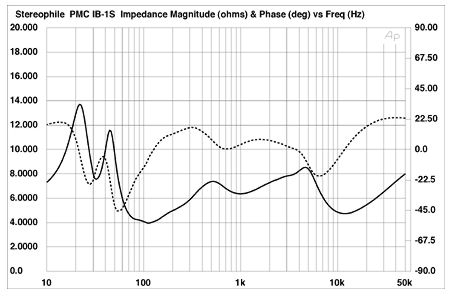
Fig.1 PMC IB-1S, electrical impedance (solid) and phase (dashed) (2 ohms/vertical div.).
The double bump in the impedance magnitude trace is typical of a reflex design. Though there is a slight discontinuity in the traces at 125Hz, there is no major sign of the upper-bass tunnel resonance that often afflicts transmission-line designs.
The individual responses of the three drive-units, along with that of the tunnel mouth, are shown in fig.2. (Measurement system was a DRA Labs MLSSA with a calibrated B&K 4006 microphone.) The crossover frequencies are basically as specified, with very steep acoustic slopes apparent. The drivers all roll out smoothly enough, though the midrange dome is a bit ragged-looking at the top of its passband. The tweeter looks to be balanced slightly hot, at least on its axis.

Fig.2 PMC IB-1S, acoustic crossover on tweeter axis at 50", corrected for microphone response, with the nearfield midrange, woofer, and port responses plotted below 500Hz, 300Hz, and 1kHz, respectively.
The woofer extends down to 60Hz, below which it rolls off quite quickly to reach a minimum-motion point at 30Hz. This is the frequency where the back pressure from the internal resonance prevents the woofer cone from moving, all the acoustic output coming from the port in a reflex design, or the mouth in a TL. But you can see from fig.2 that the line's mouth output actually reaches a maximum a little above that frequency and extends almost two octaves higher.
As shown in fig.3, the port output reinforces that of the woofer throughout the 40–120Hz region, with a very sharp rolloff below 40Hz and a lack of energy in the lower midrange before the woofer crosses over to the midrange dome. I suspect that it is this relative lack of energy in the frequency region where orchestral sounds have much of their power that bothered KR, as he indeed hypothesized. And the broad overlap between port and woofer will contribute to the bass "boom" he noted in his auditioning.
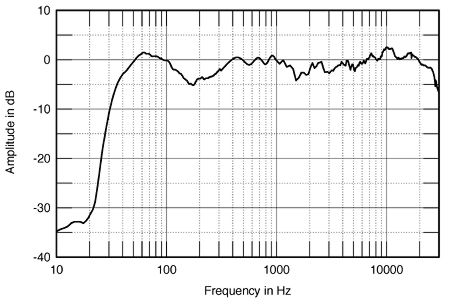
Fig.3 PMC IB-1S, anechoic response on tweeter axis at 50", averaged across 30º horizontal window and corrected for microphone response, with complex sum of the nearfield midrange, woofer, and port responses plotted below 300Hz.
Moving further up in frequency in fig.3, the IB-1S's balance is relatively even throughout the rest of the audio band, with a slight lack of on-axis energy in the upper midrange (or an excess in the middle of the midrange, depending on how the listener perceives this) and a small amount of excess energy in the top octave. However, as can be seen in fig.4, which plots the changes in the response as the microphone moves to the speaker's side in 5º increments up to 90º, the off-axis behavior will to a large extent compensate for the on-axis dip and peak. In particular, the cursor in fig.4 picks out the off-axis flare at 1.6kHz (or, looking at this another way, the relative lack of off-axis energy in the middle of the midrange). The tweeter's output in the top audio octave can also be seen to roll off quite quickly to the sides, which in a typical room will compensate for the excess of on-axis energy in this region. But sit close or in a very lively room and the tweeter will call attention to itself, as KR found in his auditioning.
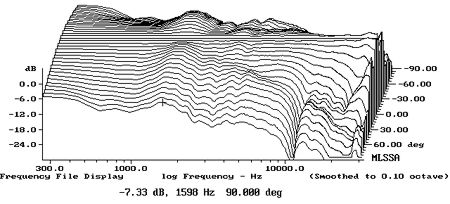
Fig.4 PMC IB-1S, horizontal response family at 50", normalized to response on tweeter axis, from back to front: differences in response 90º–5º off-axis; reference response; differences in response 5º–90º off-axis.
In the vertical plane (fig.5), the use of steep-slope crossover filters results in very little off-axis change in balance. As long as the listener sits with his or her ears between the top of the cabinet and the bottom of the midrange dome, the perceived balance will not vary too much. Only above or below that region does a suckout appear at the upper crossover frequency (shown by the cursor).

Fig.5 PMC IB-1S, vertical response family at 50", normalized to response on tweeter axis, from back to front: differences in response 15º–5º above HF axis; reference response; differences in response 5º–15º below HF axis.
The PMC's step response (fig.6) is absolutely normal, revealing that all three drive-units are connected with the same positive acoustic polarity and that the design is not time-coherent, as is to be expected from its flat baffle and high-order crossover. The associated waterfall or cumulative spectral-decay plot (fig.7) is basically clean, suggesting good presentation of recorded detail, but a slight ridge of resonant energy—probably some kind of mode in the midrange dome—can be seen at 4.4kHz.
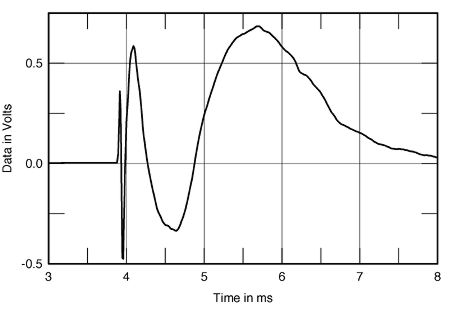
Fig.6 PMC IB-1S, step response on tweeter axis at 50" (5ms time window, 30kHz bandwidth).
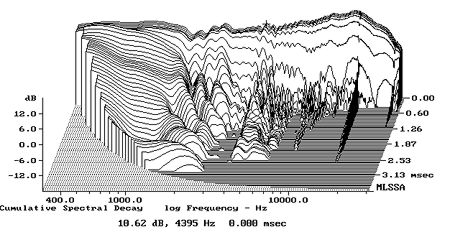
Fig.7 PMC IB-1S, cumulative spectral-decay plot at 50" (0.15ms risetime).
Finally, KR noted that he felt some vibrations on cabinet surfaces, "especially the crossover panel." Using a simple PVDF plastic-tape accelerometer to capture impulse responses for each of the panels, I found the IB-1S's side panels to be quite dead. A vibrational mode at 215Hz could be detected on the top panel, however, and this mode was very strong on the speaker's rear panel. This can be seen in the waterfall plot calculated from the accelerometer's output when it was fastened to the back wall just above the crossover panel (fig.8). Fortunately, this panel faces away from the listener, so its subjective effect might well be minimal.

Fig.8 PMC IB-1S, cumulative spectral-decay plot of accelerometer output fastened to cabinet back wall above crossover panel. (MLS driving voltage to speaker, 7.55V; measurement bandwidth, 2kHz.)
The PMC's measured performance in the midrange and treble are both excellent, throwing into sharp relief its relative lack of achievement in the bass. As Kal notes in his Sidebar on transmission lines, I am somewhat skeptical of the concept. Unfortunately, the PMC IB-1S doesn't mitigate my prejudice against the concept, its low-frequency idiosyncrasies being due, in my opinion, to its TL design. I feel that a more conventional reflex, or even sealed-box, alignment would have produced a better all-around speaker design.—John Atkinson
- Log in or register to post comments




































